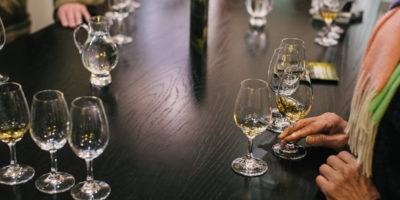The increasing prevalence of No Age Statement (NAS) whisky has been widely discussed in recent years. Scotch was seemingly hit hardest first, followed by bourbon and American whiskey. Now, Japanese whisky is being affected, its surging global popularity and heretofore unseen demand coming back to haunt it.
In an industry where increasing supply to catch up with demand could take six, eight, 12 or more years, sudden spikes in purchasing deplete stocks, leading to product shortages, allocations, unavailability, or discontinuation. For brands to survive, they have to adapt to their circumstances, and the most commonly forged path to sustain product on the shelf while also restocking for the future is to turn towards NAS whisky.
The massive thirst for Japanese whisky has put the category in the same position that many Scotch and bourbon producers have already been in, the problem of popularity. Japanese whisky has been the toast of the town over the past year, hauling in accolades with the consumer attention and dollars to match.
The two kingpins of Japanese whisky have basked in the limelight, and now find themselves burdened by their own success. Suntory Whisky, now Beam Suntory after their $16 billion outlay to purchase Jim Beam and its portfolio, produce the Yamazaki, Hibiki and Hakushu brands, and Nikka, owned by Asahi Breweries, produces its own diverse lineup including the Single Malt Yoichi and Single Malt Miyagikyo families. The former has released a new NAS Hibiki, Hibiki Japanese Harmony, while the latter has announced a near universal change to the whisky they’re selling.
Why Switch to NAS Japanese whiskies?
A brand not hindered by an age label has far greater flexibility. The whisky being sold could take a variety of routes towards achieving a familiar flavor profile beyond merely hitting an age, from time spent in different areas of a warehouse or in barrels of different sizes and casks of different types, to changes in blending ratios and strategies.
“Nikka really shows the blending capabilities of the Japanese,” says Dennis Carr, President of Anchor Distilling Company, the U.S. importer for Nikka. In discussions with the brand about Taketsuru Pure Malt 12, which was previously stripped of its age and is now simply Taketsuru Pure Malt, an idea had been floated to offer a younger age as opposed to an NAS. “We thought it really wasn’t about the age, it’s about [Nikka’s] blending ability,” explains Carr. “Especially with that particular item, where they’re blending between the two distilleries of the brand.”
They say a move to NAS will help them improve
Distilleries from Bardstown to Speyside to Yoichi all stand firm by the fact that once freed from an age statement, quality can actually be improved.
“We want to allow ourselves the flexibility to ensure that Hibiki Japanese Harmony delivers on our desire to produce the perfect blend of multiple different whiskies,” says Gardner Dunn, senior ambassador for Suntory Whisky. “In order to maintain this blending flexibility, we do not want to limit the possibilities based on one individual number or age requirement.”
It’s a common talking point, but talk is cheap, and whisky isn’t, so the ultimate test is always going to be final product quality, not corporate buzzwords.
“I think what it does is that it allows them to do what they do best, which is find the best characteristics of different whiskies and bring it together,” says Carr. “When you’re confined to one age, that limits what you can do. When they took that constraint off [Taketsuru 12], I actually think the product [Taketsuru Pure Malt] they put together for us is even better.”
Nikka Changes Their Entire Lineup
Asahi released a statement in June which effectively eliminated their entire age-specific range. In Japan, the Single Malt Yoichi and Miyagikyo lines will have new expressions launched as of September this year, all of which will be NAS. Foreign markets will see the new expressions in 2016. Their statement noted:
“Following the Japanese whisky boom in foreign markets and due to the growing popularity in the domestic market… Yoichi and Miyagikyo malt whiskies, which are the base of most of our products, will be exhausted in the future and we will be unable to continue the business.”
Anchor followed up Nikka’s announcement with one of their own, citing that the popular Nikka Coffey Grain and Taketsuru Pure Malt labels will continue to be available in the United States.
As Nikka’s statement indicated, it’s not only global demand which has spurred on this crisis of sorts, but also domestic interest. “At the onset of last year, there was a documentary in Japan about [Masataka] Taketsuru and the Nikka distillery, and it became very, very popular in domestic Japan,” explains Carr. “Not only was the Japanese whisky category already growing in popularity, I think what that did was kick into gear the domestic demand.”
Forecasting demand is incredibly difficult
The domestic market will also be much harder hit than the foreign market. Already in the U.S., the majority of the aged single malt expressions from Nikka have not been available, and the NAS Nikka Coffey Grain is their top selling offering. Carr reports that through the first six months of this year there has been a more than 300% growth in sales of the acclaimed Coffey Grain.
“There’s no way we can forecast for that,” he says. “If we can’t forecast for it, they certainly didn’t seven years ago when they were starting to lay down stock.”
Inability to forecast demand, and the time it takes to adjust, is a recurring focal point. “It is difficult for whisky makers to adjust to a rapid change in trend,” notes Dunn.
“Our biggest challenge as a company is how to meet rising global demand with a product that takes a long time to make,” explains Craig Bridger, brand ambassador for The Macallan. While he’s discussing his brand, a Scotch, the sentiment rings true for any whisk(e)y, and reinforces the similarities from one sector of the industry to another.
“At Macallan, we’re at an enviable position where demand pretty consistently outstrips supply. It has been that way for many years. It’s a great problem. But it’s something we have to manage.”
Suntory Releases Hibiki Japanese Harmony
In Hollywood, it’s not unusual to see two rival production companies release similarly themed movies at nearly the same time – Armageddon and Deep Impact, both summer 1998, The Illusionist and The Prestige, both fall 2006, Mission to Mars and Red Planet, both 2000, Dante’s Peak and Volcano, both 1997, and so forth, but I digress. It’s also not unusual to see competing brands respond similarly to the same market conditions. While Nikka has overhauled its entire lineup, Suntory’s Hibiki brand has instead focused current efforts on replacing Hibiki 12 with the new Hibiki Japanese Harmony.
“We are extremely fortunate that the demand for Japanese whisky is consistently increasing every year,” says Dunn. “Foreseeing this continuous demand, we face limitations on the potential supply of our aged whiskies. We are launching Hibiki Japanese Harmony to ensure that a wider audience will have accessibility to Japanese whisky… We decided to make it a no age statement whisky because we wanted to leverage a wide variety of component whiskies regardless of aging in order to realize this designed product.”
The challenge to Master Distillers
Yet, Suntory’s Chief Blender Shinji Fukuyo had to wrap his own head around the challenge before he knew how best to proceed. “I had never thought of using whisky younger than 12 years for Hibiki,” he acknowledged at a recent launch event in Manhattan for Japanese Harmony. So while the brand drives home the point that flexibility is key, the supply of aged stock is of course the driving force.
Fukuyo put to use Suntory’s myriad distilleries, fermentation styles, types of stills, and range of casks and barrels, and all of the resulting diverse stock it produces, to create an NAS product which lived up to the brand’s standards – in his words, to match “The Hibiki-ness of Hibiki.”
At the launch, Fukuyo led a tasting of five component whiskies of Japanese Harmony to demonstrate how a blend is put together piece by piece. There’s the grain whisky from the Chita distillery, the largest component of the blend by volume, contributing fruity and floral notes, and a creamy mouthfeel; there’s the Mizunara cask malt whisky, a “dressing element” designed to specifically deliver the “distinctive Japanese” long, spicy aftertaste; and so forth.
A lot of this and a bit of that and some more of another, and the end result is a nuanced, complex blend. “It represents the essence of the Hibiki brand,” says Fukuyo.
What Does it All Mean?
There’s nothing inherently wrong with NAS whisky. There’s a huge range of fantastic NAS whiskies, whether they never had an age statement, or they’re newly NAS, and as discussed, many in the industry insist upon the ideal that the increased flexibility of NAS whisky leads to both superior quality and greater consistency.
Yet, it’s a change, and consumers struggle with the loss of both easy store-shelf distinction between ages, as well as the loss of comfort of a familiar, previously sampled commodity. Of course, if consumers are having a hard time adjusting to life without age labels, it’s not their fault.
“In some respects, the whisky industry has to raise a hand and plead guilty to that,” acknowledges Bridger. “We sort of taught people that that’s the way you judge a whisky, for a long time.”
The challenge to brands famous for age statements
It’s something a brand like The Macallan, so strongly associated with its range of age labels, has struggled with, particularly with American whisky drinkers. “The U.S. consumer is especially dedicated to the idea of age statements,” he notes. That’s why the United States still has the familiar lineup of The Macallan 10, 12, 15, 18, and so forth, whereas much of the rest of the world now has access only to The Macallan 1824 Series, including The Macallan Gold, Amber, Sienna and Ruby.
The Macallan Rare Cask, a premium NAS expression replete with a Lalique-designed bottle, now available exclusively in the U.S., consists of almost entirely first-fill sherry casks, and utilizes a carefully chosen range of less than 1 percent of The Macallan’s casks. It falls somewhere between The Macallan 18 and 25 stylistically, and for confused U.S. consumers not sure of what to make of the lack of age on the bottle, Bridger suggests a bit of an eye test.
“We don’t use any caramel coloring in any of our whiskies,” he says. “When you see that wonderful, ruby red, you can’t cheat that. Only long, careful maturation with proper casks can give you that color.”
Time will tell
Now, American whisky enthusiasts will try their hands at adjusting to Japanese NAS whiskies. Taketsuru Pure Malt, and not Taketsuru 12. Hibiki Japanese Harmony, and not Hibiki 12. As long as quality stays in line with price, no harm no foul, and after an initial hopefully brief period of confusion, things will run smoothly for both brand and consumer. Yet, for a category which is so freshly at the forefront in this country, it will be intriguing to see if there’s any backlash or downturn as a result.
Find the next Japanese whisky for your home bar today!
With Distiller, you’ll always know what’s in the bottle before you spend a cent. Rate, Review, and Discover spirits! Head on over to Distiller, or download the app for iOS and Android today!


